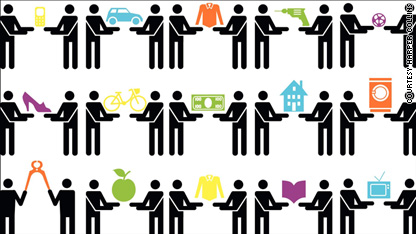In a Revolution, Things Break

We’re a small organization with a tremendous privilege. Through a bit of luck and a lot of hard work, we have a front row seat to what we’re beginning to think is a revolutionary time in business–and maybe in economics as well. We’re looking at two changing business models in particular.
Business models. Dull stuff. Except that these changes could have a profound and lasting effect…
on the lives of millions of ordinary people. And it may break a lot of established models. We think there is real change coming in the next decade or so. If you’re sitting on an established business that can’t change and may lose market share, this is altogether unwelcome. If, like us, you’re working to make the change, it’s potentially a beautiful revolution.
No one at Schaffer&Combs is writing a book about any of this (yet). We’re putting the models into practice, learning by doing. Our internal method is to float an idea and have everyone do their best to punch holes in it. If it still floats, we implement it. Then the market takes its hacks at the idea. So far, we can’t break the models. From down here on the ground they look viable, smart, profitable.
Sharing and Collaboration as a Profitable Business Model
This idea isn’t brand new–lots of industries have found ways to source goods and services without owning them. But ownership is still by far the dominant model.
We’ve been watching the business literature on this movement (particularly The Mesh, by Lisa Gansky, and What’s Mine is Yours: the Rise of Collaborative Consumption, by Rachel Botsman and Roo Rogers). In large part, Schaffer&Combs’s own value proposition to clients rests on this model. Using our shared internal resources (office, equipment, staff, brain power, connections) we provide the services of a full time employee, a department, or an entire agency to our clients for less than it would cost them to “own” these resources in the traditional, individualist manner. Through scale and good management, this collaborative model is working both for us, and for our clients.
The model has been around for centuries without consumers giving it much thought. English travelers owned carriages but shared horses. Shared corporate jets, factory lines, retirement villages, condominium complexes and Internet cafes all depend upon variants of the collaborative consumption model. But entrepreneurs are now starting to apply the model to nearly everything. There’s a lot of trial and error to come. It won’t work in all businesses, but in many, many industries, from cars to office space, the collaborative model is making profits in new ways.
Our own office is an example of collaborative economics. We rent by the individual Schaffer&Combs staffer. For the cost of each worker, we get every possible office amenity: desk space, connectivity, conference rooms, private offices, printing paper, and coffee. We have office privileges in 30 cities worldwide. It’s also worth noting that we have access to the minds of hundreds of other entrepreneurs. The services are as comprehensive as they would be if we built our own, ideal office, but are far cheaper.
Some of the new business literature extolls the superior moral and environmental aspects of this burgeoning model, and they have a point. But we are pragmatists and this is a viable business model. If it’s not profitable, all the good intentions in the world won’t save it from the dust heap.
In a few days: the second revolution in business models in which we have the good fortune to work–social entrepreneurship vs. the Big plan in international aid.
Recent Posts
- Our Search Division is Ramping Up to Meet Increasing Demand for Talented, Purpose-Driven Executives
- 2020 Demanded Smart Strategies From Every Organization – Here’s What We’ve Been Working On
- S&C supports major new alliance in apparel industry
- Call it What it is: Power
- Schaffer&Combs places Higg Co’s incoming Vice President, Marketing & Communications and Senior Manager Sales
Recent Comments